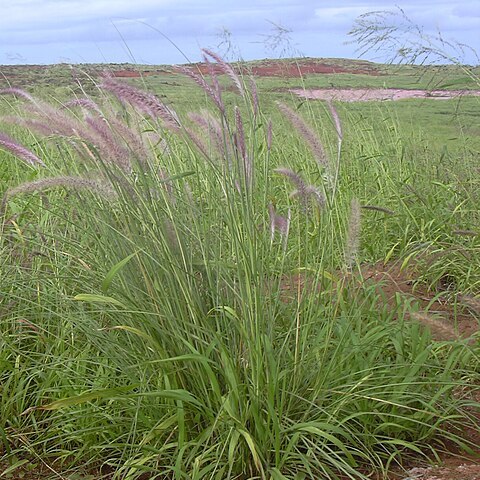Tufted perennial 600-1 000 mm high. Leaf blade 20-40 x 1-2 mm, often rolled, rigid, rough, midrib conspicuously thickened on upper surface; glaucous; ligule a fringe of hairs. Inflorescence 100-250 mm long, spike-like, often purple; rachis cylindrical with shallow angular ribs below stumpless scars, glabrous to hairy; involucre enclosing 1-3 spikelets, one sessile, rest pedicelled, borne on a basal stipe 1-3 mm long, hairy; bristles mostly ± 4-5 x as long as spikelet, longest 16-40 mm long, usually purple, at least inner ones plumose. Spikelet 4.0-6.5 x 3 mm; occasionally rachilla prolonged beyond upper lemma as a tiny bristle; lower glume short, subrotund to ovate, up to 1/3 the spikelet length or suppressed; upper glume 1/4-2/3 the spikelet length, acute to acuminate; lemmas similar; lower floret male or sterile, lemma as long as spikelet; anthers 1.8-2.0 mm long, without a tuft of hairs at apex.
Tufted perennial, 0.2-1.0 m high. Leaf blade 20-40 x 1-2 mm, often rolled, rigid, rough; ligule a fringe of hairs. Inflorescence a spike-like panicle, 60-250 mm long, purple; rachis cylindrical with shallow angular ribs below stumpless scars, glabrous to hairy; involucre borne on a stipe, enclosing 1-3 spikelets, one sessile, rest pedicelled; bristles mostly ± 20 mm long but longest 16-40 mm, 4-5x as long as spikelet, usually purple, inner bristles plumose. Spikelet 4.0-6.5 x 3 mm; occasionally rachilla prolonged beyond upper lemma as tiny bristle; glumes unequal; lower glume short and subrotund or sometimes ovate and up to 1/3 length of spikelet, sometimes suppressed; upper glume 1/4-2/3 length of spikelet, acute to acuminate. Florets 2; lower floret male or sterile, lemma as long as spikelet; upper floret bisexual; anther 1.8-2.0 mm long, without tuft of hairs at apex. Flowering time Nov.-July.
Densely tufted perennial; culms 20–130 cm. high.. Leaf-blades up to 30 cm. long and 3 mm. wide, convolute with the midrib noticeably thickened on the upper surface, rigid, harsh, glaucous.. Panicle linear, 6–30 cm. long; rhachis cylindrical with shallow angular ribs below the stumpless scars, glabrous to pilose; involucre borne upon a slender pubescent stipe 1–3 mm. long, enclosing 1–3 spikelets, one of them sessile the others shortly pedicelled; bristles, at least the inner, loosely plumose, the longest 16–40 mm.. Spikelets lanceolate, 4.5–6.5 mm. long; lower glume occasionally ovate and up to 1/3 the length of the spikelet, usually shorter and subrotund, sometimes suppressed; upper glume 1/4–2/3 the length of the spikelet; lower lemma as long as the spikelet, ♂ or barren, acuminate; upper lemma similar to the lower; occasionally the rhachilla prolonged beyond the upper lemma as a tiny bristle.
Panicle 6–30 cm. long, linear; rhachis cylindrical with shallow angular ribs below the stumpless scars, glabrous to pilose; involucre borne upon a slender pubescent stipe 1–3 mm. long, enclosing 1–3 spikelets, one of them sessile the others shortly pedicelled; bristles, at least the inner, shortly plumose, the longest 16–40 mm.
Perennial; up to 1 m high; tufted. Leaf blades 20-40 x 1-2 mm. Flowers: inflorescence a spike; purple; 100-250 mm long; rachis ribs angular; involucre with 2-4 spikelets; stipe present; longest involucral bristles 17-40 mm long; 4-5 x as long as spikelets; inner bristles plumose; spikelets 4.0-6.5 x 3 mm.
Perennial, tufted, 1 m high. Leaf blades 20-40 mm long, 1-2 mm wide. Spikelets 4.0-6.5 mm long, 3 mm wide. Inflorescence purple, 100-250 mm long; involucral bristles, mostly ± 20 mm long, 4-5 times as long as spikelets, inner bristles plumose.
Inferior glume up to 1/3 length of spikelet, usually subrotund, sometimes suppressed; superior glume 1/4–2/3 length of spikelet.
Like P. macrourum but bristles 4-5 times as long as spikelets, the inner plumose, spikelets 4-6.5 mm long.
Leaf laminae convolute with midrib noticeably thickened on upper surface, rigid, harsh, glaucous.
Superior lemma similar to inferior, occasionally the rhachilla prolonged as a tiny bristle.
Inferior lemma as long as spikelet.
Spikelets 4.5–6.5 mm. long.
Hard glaucous leaf-blades.
Densely tufted perennial.
Densely tufted perennial
Culms 20–130 cm. high.

